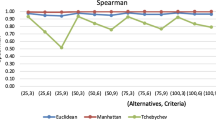Abstract
A problem of axiomatic construction of a social decision function is studied for the case when individual opinions of agents are given as m-graded preferences with arbitrary integer m ≥ 3. It is shown that the only rule satisfying the introduced axioms of Pairwise Compensation, Pareto Domination and Noncompensatory Threshold and Contraction is the threshold rule.
Similar content being viewed by others
References
Aizerman M, Aleskerov F (1995) Theory of choice. North-Holland, Amsterdam
Aleskerov F (1999) Arrovian aggregation models. Kluwer Academic Publishers, Dordrecht
Aleskerov FT, Chistyakov VV (2008) Aggregating m-graded preferences: axiomatics and algorithms. In: Talk at the 9th international meeting of the society for social choice and welfare, Montreal, Concordia University, Canada, June 19–22, 2008
Aleskerov FT, Yakuba VI (2003) A method for aggregation of rankings of special form. In: Abstracts of the 2nd international conference on control problems. IPU RAN, Moscow, Russia, p 116
Aleskerov FT, Yakuba VI (2007) A method for threshold aggregation of three-grade rankings. Dokl Math 75:322–324 [Russian original: Dokl Akad Nauk 413:181–183]
Aleskerov F, Yakuba V, Yuzbashev D (2007) A ‘threshold aggregation’ of three-graded rankings. Math Social Sci 53: 106–110
Aleskerov F, Chistyakov VV, Kalyagin V (2010) The threshold aggregation. Econ Lett 107(2): 261–262
Arrow KJ (1963) Social choice and individual values. 2nd ed. Yale University Press, London
Austen-Smith D, Banks J (1999) Positive political theory I: collective preferences. University of Michigan Press, East Lancing
Brams SJ, Fishburn PC (2002) Voting procedures. In: Arrow KJ, Sen AK, Suzumura K (eds) Handbook of social choice and welfare, vol 1, 1st edn, Chap 4. Elsevier, pp 173–236
Chistyakov VV, Kalyagin VA (2008) A model of noncompensatory aggregation with an arbitrary collection of grades. Dokl Math 78:617–620 [Russian original: Dokl Akad Nauk 421:607–610]
Fishburn PC (1973) The theory of social choice. Princeton University Press, Princeton, NJ
Graham RL, Knuth DE, Patashnik O (1994) Concrete mathematics. A foundation for computer science. Addison-Wesley Publishing Company, Reading
May KO (1952) A set of independent, necessary and sufficient conditions for simple majority decision. Econometrica 20(4): 680–684
Moulin H (1988) Axioms of cooperative decision making. Cambridge University Press, Cambridge
Smith JH (1973) Aggregation of preferences with variable electorate. Econometrica 41(6): 1027–1041
Young HP (1974a) A note on preference aggregation. Econometrica 42(6): 1129–1131
Young HP (1974b) An axiomatization of Borda’s rule. J Econ Theory 9(1): 43–52
Young HP (1975) Social choice scoring functions. SIAM J Appl Math 28(4): 824–838
Author information
Authors and Affiliations
Corresponding author
Rights and permissions
About this article
Cite this article
Aleskerov, F.T., Chistyakov, V.V. & Kalyagin, V.A. Social threshold aggregations. Soc Choice Welf 35, 627–646 (2010). https://doi.org/10.1007/s00355-010-0454-9
Received:
Accepted:
Published:
Issue Date:
DOI: https://doi.org/10.1007/s00355-010-0454-9




